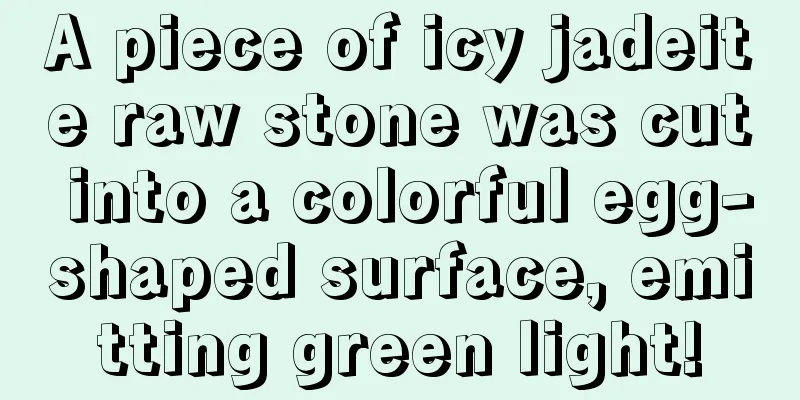It's obvious that the certificate is fake! The easiest way to identify jadeite

|
Whenever we talk about buying jadeite, Teng Pu Pavilion always reminds everyone to "carefully distinguish the real from the fake"! In the eyes of my friends, I am an expert on jadeite raw stones. I can tell the authenticity of jadeite at a glance. These are the experience and skills accumulated over more than 20 years. I will share them with everyone in Teng Pu Pavilion regularly, so that everyone can quickly and truly understand the jadeite raw stones, avoid detours, and let friends who like jade have a correct understanding when purchasing jadeite products, and don't be deceived and waste money! This is also the original intention of our Tengpu Pavilion! Every time when talking about buying jadeite, Teng Puge always reminds everyone to "carefully distinguish the real from the fake"! But for most laymen, even if they have looked at the jadeite dozens of times, they still can't find any problems. What can they do? In fact, it is enough for most jade enthusiasts to understand the following knowledge about jade! 1. What is genuine jade? Generally speaking, what we call genuine jade is Grade A jade, which is pure natural jade that has only been carved and polished without any chemical treatment, and has not been artificially falsified by high heat or high pressure. The color has not been dyed or electroplated. It is called "genuine color" or "real color." Depending on the degree of jade processing, jade can be divided into A-grade jade, B-grade jade, C-grade jade and B+C-grade jade. Grade A jadeite refers to natural jadeite that has not been artificially processed, while grade B jadeite is jadeite that has undergone a certain degree of optimization treatment such as bleaching and glue filling, and grade C jadeite is jadeite that has been artificially dyed. 2. How to identify the authenticity of jadeite? First of all, we need to look at the texture. Many fake jades are acid-washed, which will have a significant impact on the surface and interior of the jade. After B-grade jade is rinsed with hydrochloric acid, there will be some uneven pits and a network of patterns on the surface of the jade, which are also called tortoise cracks. With the help of scientific instruments, it can be found that the internal structure of acid-washed jade is very loose. The surface of A-grade jadeite products will be uneven, which is known in the industry as the "orange peel effect." The coarser the jadeite mineral particles, the more obvious the orange peel effect will be. Cracking and orange peel patterns are important methods for identifying the authenticity of jadeite. Looking at the color of jadeite, it is rare for natural jadeite to have uniform color distribution. Usually the distribution is uneven and the color depth is also inconsistent. The dyed jade is uniform and even in order to cater to people's pursuit of color, some merchants dye it into "full green jade". Artificially dyed jade has its internal structure destroyed, so the color accumulates and settles in the gaps, and the boundaries are blurred and diffuse, without the natural transition like natural jade. Then you can also use instruments to identify it. Under the Charles filter, some dyed green jadeite will turn red; under ultraviolet light, some dyed red jadeite will emit yellow-green or orange-red fluorescence. Natural jade has no fluorescence under ultraviolet light. Of course, these methods of identifying natural jade and artificial jade are not necessarily applicable to all jade, and should be used flexibly during the identification process. When purchasing jadeite, asking the seller to issue a formal invoice and appraisal certificate is also one of the ways we can avoid being cheated. In addition, based on many years of experience in the jade industry, we have summarized a complete set of effective jade identification methods. Comments and exchanges are welcome. fcgc66 fcpf18 |
<<: Share the identification method of jadeite
>>: What is the meaning of jade leaves? How to choose the right jade leaf?
Recommend
Revealing the "three major killers" who impersonate Violet, all exposed in one article!
Speaking of shortcuts to getting rich overnight, ...
Choose jade accessories with your face, only the right one can highlight the beauty
Jade jewelry is a treasure sought after by many w...
Correct identification method of jadeite
Many people like jade, but don’t know how to choo...
Jade ornaments are not only luxurious and elegant, but also auspicious.
As the saying goes, “jade cannot be made into a u...
The historical status and value of jadeite in Chinese jade culture
Chinese jade culture has a long history. In the l...
The origin of the bracelet, the story of the jade bracelet
Jade bracelets have set off a craze in modern tim...
The finest glass-bottomed sunny green jadeite is available, so beautiful that it is beyond imagination!
The beauty of jade is different at every stage, e...
What is the meaning of jade bracelets?
There is a legend about the bracelet: The prince ...
Full green jadeite material, custom engraved domineering green lion jade seal
Today I would like to share with you the process ...
The combination of jade necklace and clothes is both retro and modern, making you beautiful and full of personality
Jade necklaces are divided into plain jade neckla...
Of these four jade maintenance methods, are you only aware of the first two?
Maintenance is the most important part of wearing...
How to design yellow and white jade materials to convey the meaning of "diligence"?
A jade friend wants to collect it as a decoration...
Simple and effective method to identify jadeite
Jade is a mineral aggregate with jadeite as the m...
Common dragon patterns and their meanings in jade carvings
"The dragon is the leader of the scaly creat...
What does jade represent?
Jade is a gem that represents love. It has the be...









